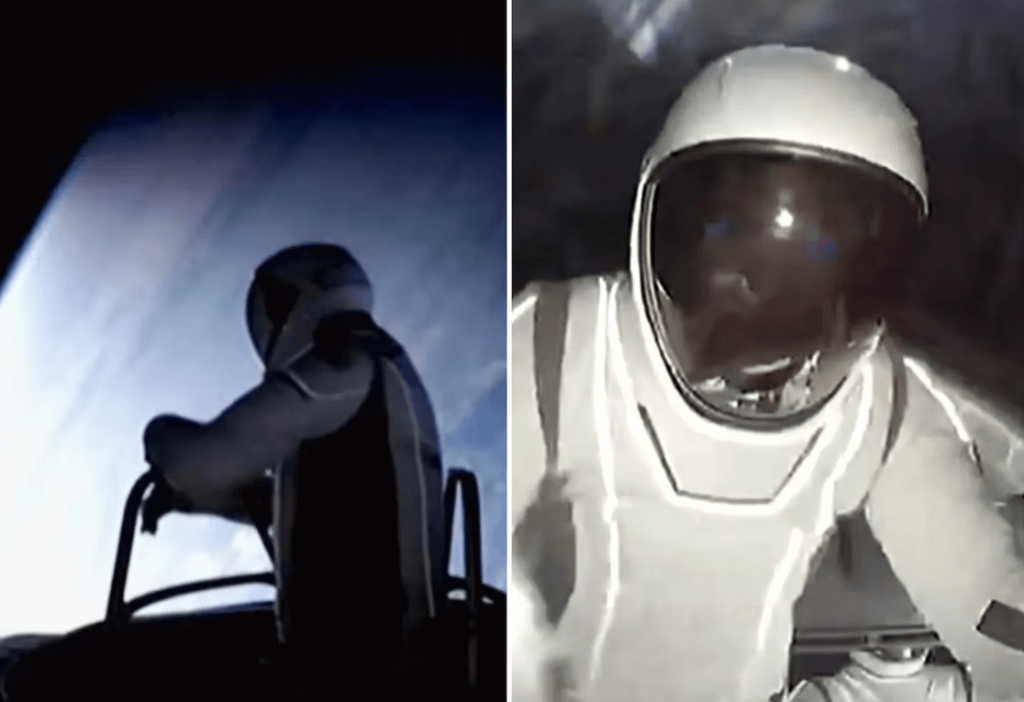【中美创新时报2024 年 9 月 13 日编译讯】(记者温友平编译)两名私人宇航员于周四凌晨走出他们的航天器,进行了首次商业太空行走。《纽约时报》记者肯尼斯·张(Kenneth Chang)对此作了下述报道。
这次太空行走是北极星黎明计划的核心,该计划由埃隆·马斯克的 SpaceX 与领导这项任务的亿万富翁企业家贾里德·艾萨克曼合作完成。
“回到家,我们都有很多工作要做,但从这里看,地球看起来确实是一个完美的世界,”他站在 SpaceX 龙飞船的舱口中,头顶上是这颗星球,说道。
这次成功的行动进一步证明,太空旅行不再是 NASA 等政府航天机构专业宇航员的专属领域,太空行走也不再是冒险之举,宇航员仅靠宇航服就能避免因缺气而丧命。北极星任务是三次任务中的第一次,旨在加速实现马斯克有朝一日将人类送上火星的愿望所需的技术进步。
NASA 局长比尔·尼尔森为这次太空行走欢呼,政府航天机构几乎没有参与其中。
“今天的成功代表了商业航天业向前迈出的一大步,也是 NASA 建立充满活力的美国太空经济的长期目标,”尼尔森在社交平台 X 上发帖称。
太空行走于美国东部时间上午 6:12 正式开始,氧气流入宇航员的宇航服。这比原计划晚了近三个小时,但操作进展顺利。
由于用于此次飞行的 SpaceX 载人龙飞船没有气闸,因此进行太空行走的唯一方法是将飞船内的所有空气排出。NASA 和苏联宇航员在 20 世纪 60 年代也以类似的方式进行太空行走。
艾萨克曼首先转动手摇曲柄,打开太空舱顶部舱门,移到舱外,在那里对他的宇航服进行了机动性测试。
对于此前人类半个多世纪以来的最高轨道之旅而言,他在太空真空中的逗留时间很短:几分钟后,艾萨克曼重新进入太空舱,另一名机组人员、SpaceX 工程师莎拉·吉利斯移到舱外,进行了同样的机动性测试。
虽然另外两名机组人员斯科特·波蒂特和安娜·梅农仍留在飞船内,但他们也穿着宇航服在真空舱内。这是四名宇航员首次同时暴露在太空真空中。
吉利斯重返大气层后,她关闭了舱门,飞船内部慢慢重新加压。太空行走开始后不到两小时,就结束了。
北极星黎明号任务的一个关键目标是开发更先进的宇航服,这些宇航服将是 SpaceX 进行外星殖民的任何尝试所必需的。在发射前的新闻发布会上,艾萨克曼沉思着,有一天踏上火星的人可能会穿上 SpaceX 为这次任务开发的未来版宇航服。
“有机会在这次飞行中测试它是一种莫大的荣幸,”他说。
在更接近地球的地方,商业太空行走可能会开辟其他曾经无法想象的可能性,比如技术人员在轨道上修理私人卫星。艾萨克曼甚至建议第二次北极星任务可以尝试前往美国宇航局老化的哈勃太空望远镜进行维修并延长其在轨寿命。
艾萨克曼和吉利斯的太空行走时间短,复杂程度适中。与科幻电影中的疯狂场景不同,他们耐心地等待着太空舱中的空气慢慢排出。然后他们有条不紊地移动,按照精心策划的舞蹈动作,只持续了几分钟。
手动打开舱门后,艾萨克曼利用安装在龙飞船顶部的栏杆将自己拉上来。他没有放开飞船,而是做了一系列动作来测试宇航服的性能。
时间到了,他又回到了龙飞船,然后吉利斯重复了同样的动作。
北极星黎明号机组人员的谨慎态度提醒人们,太空本质上是一个不适宜居住和危险的环境,在太空行走期间,宇航员被包裹在一个小气泡中——他们的宇航服——以防止他们在太空真空中窒息。
虽然太空行走过程中曾发生过险些事故,包括 1965 年苏联宇航员的首次太空行走,但走出航天器并不是航天飞行中最危险的部分。从未有宇航员在太空行走过程中死亡或受重伤。太空行走并不罕见:自 1998 年 12 月以来,国际空间站已进行了 270 多次太空行走,基本没有发生事故。(国际空间站的宇航员通过气闸进出空间站,最大限度地减少了释放到太空中的空气量。)
太空飞行中的死亡事件发生在发射过程中,例如 1986 年挑战者号航天飞机及其机组人员的损失,或着陆过程中,例如 2003 年哥伦比亚号航天飞机在重返地球大气层时因高温而燃烧。
北极星黎明号任务迄今为止进展顺利。
周二凌晨,SpaceX 猎鹰 9 号火箭将载人龙飞船和四名宇航员送入椭圆轨道,最高点距离地球表面 755 英里。
这是自 20 世纪 70 年代 NASA 的阿波罗登月任务以来,飞船飞到离地球最远的地方。
周二晚些时候,推进器启动,将轨道延伸到约 870 英里的最高点。这超过了 1966 年 NASA 两名宇航员 Pete Conrad 和 Richard Gordon 在双子座 XI 任务期间达到的 853 英里高度,这是宇航员在非月球飞行中的飞行距离记录。
在高轨道上绕地球六圈后,载人龙飞船返回低轨道,那里的辐射和微流星体危害较小。
在太空飞行期间,四名机组人员进行了大约 40 次实验,主要是研究失重和辐射对人体的影响。他们还测试了龙飞船与 SpaceX 的 Starlink 互联网卫星群之间的激光通信。
本文最初发表于《纽约时报》。
题图:SpaceX 提供的视频图像显示,贾里德·艾萨克曼(左)周四开始首次私人太空行走,而 SpaceX 工程师莎拉·吉利斯(右)在艾萨克曼返回后离开太空舱。SPACEX/NYT
附原英文报道;
First private spacewalk in SpaceX capsule achieves new milestone
By Kenneth Chang New York Times,Updated September 12, 2024
Images from video provided by SpaceX shows Jared Isaacman, left, as he begins the first-ever private spacewalk on Thursday and Sarah Gillis, right, a SpaceX engineer, exiting the capsule after Isaacman’s return.SPACEX/NYT
Two private astronauts moved outside their spacecraft early Thursday morning, conducting the first-ever commercial spacewalk.
The spacewalk was the centerpiece of Polaris Dawn, a collaboration between Elon Musk’s SpaceX and Jared Isaacman, a billionaire entrepreneur who is leading the mission.
“Back at home, we all have a lot of work to do, but from here, Earth sure looks like a perfect world,” he said while standing in the hatch of the SpaceX Crew Dragon capsule with the planet above his head.
The successful operation further reinforces that space travel is no longer the exclusive province of professional astronauts working at governmental space agencies like NASA, and now neither is the derring-do of spacewalks, when astronauts are protected by just their spacesuits from airless doom. The Polaris missions — this one is the first of three — aim to accelerate technological advances needed to fulfill Musk’s hope of sending people to Mars someday.
Bill Nelson, the NASA administrator, cheered the spacewalk, which the government space agency played almost no role in.
“Today’s success represents a giant leap forward for the commercial space industry and NASA’s long-term goal to build a vibrant US space economy,” Nelson posted on the social platform X.
The spacewalk officially began at 6:12 a.m. Eastern time with the flow of oxygen into the astronauts’ spacesuits. That was almost three hours later than originally planned, but the operation proceeded without a hitch.
Because there is no airlock in the SpaceX Crew Dragon spacecraft used for the flight, the only way to perform a spacewalk is to let all of the air out of the spacecraft. NASA and Soviet astronauts conducted spacewalks in a similar manner in the 1960s.
First turning a hand crank, Isaacman opened the top hatch of the capsule and moved outside, where he conducted mobility tests of his spacesuit.
For a journey that earlier had traveled to the highest orbit by humans in more than a half-century, his sojourn in the vacuum of space was brief: After a few minutes, Isaacman reentered the capsule, and another crew member, Sarah Gillis, a SpaceX engineer, moved outside and performed the same mobility tests.
Although the two other crew members, Scott Poteet and Anna Menon, remained inside the vehicle, they were also wearing spacesuits inside the airless capsule. It was the first time that four astronauts were simultaneously exposed to the vacuum of space.
After Gillis reentered, she closed the hatch, and the inside of the spacecraft was slowly repressurized. Less than two hours after it started, the spacewalk was over.
A key goal of the Polaris Dawn mission is the development of more advanced spacesuits that would be needed for any attempt at off-world colonization by SpaceX. During a news conference before the launch, Isaacman mused about how someone stepping onto Mars might one day wear a future version of the spacesuit that SpaceX developed for this mission.
“A huge honor to have that opportunity to test it out on this flight,” he said.
Closer to Earth, commercial spacewalks could open up other possibilities once impossible to imagine, such as technicians repairing private satellites in orbit. Isaacman has even suggested that the second Polaris mission could attempt a trip to NASA’s aging Hubble Space Telescope to perform repairs and extend its life in orbit.
The spacewalks by Isaacman and Gillis were short and modest in complexity. Unlike frantic scenes in science fiction movies, they waited patiently as air was slowly evacuated from their capsule. Then they moved methodically, following a carefully planned choreography that lasted only a few minutes.
After opening the hatch manually, Isaacman pulled himself upward using a railing mounted to the top of the Crew Dragon. He never let go of the spacecraft as he performed a series of movements to test the capabilities of the spacesuits.
When his time was up, he moved back down into the Crew Dragon, and Gillis then repeated the same actions.
The Polaris Dawn crew’s cautious approach was a reminder that space is an inherently inhospitable and dangerous environment, and during spacewalks astronauts are enclosed in a small bubble of air — their spacesuits — that keep them from suffocating in the vacuum of space.
While there have been near misses during spacewalks, including during the first spacewalk by a Soviet astronaut in 1965, going outside a spacecraft is not the most dangerous part of spaceflight. No astronauts have ever died or suffered serious injury during a spacewalk. And spacewalks are not infrequent: There have been more than 270 spacewalks conducted at the International Space Station since December 1998 largely without incident. (Astronauts at the ISS enter and exit the space station through airlocks, minimizing the amount of air that is released into space.)
Fatalities during spaceflight have occurred during launches, as was the case with the loss of the space shuttle Challenger and its crew in 1986, or during landings, like when the space shuttle Columbia burned up in the searing heat of reentry through Earth’s atmosphere in 2003.
The Polaris Dawn mission has so far gone smoothly.
A SpaceX Falcon 9 rocket launched the Crew Dragon capsule and the four astronauts early Tuesday morning into an elliptical orbit that, at its highest point, was 755 miles above Earth’s surface.
That was the farthest off the planet that anyone has gone since NASA’s Apollo moon missions in the 1970s.
Late Tuesday, the thrusters fired to stretch its orbit to a high point of about 870 miles. That surpassed the 853-mile altitude that two NASA astronauts, Pete Conrad and Richard Gordon, reached during the Gemini XI mission in 1966, which had been the record distance for astronauts on a spaceflight not headed to the moon.
After circling Earth six times in the high orbit, the Crew Dragon returned to a lower orbit, where there is less danger from radiation and micrometeoroids.
During their spaceflight, the four crew members are conducting about 40 experiments, mostly investigating how weightlessness and radiation affect the human body. They have also tested laser communications between the Crew Dragon and SpaceX’s constellation of Starlink internet satellites.
This article originally appeared in The New York Times.

